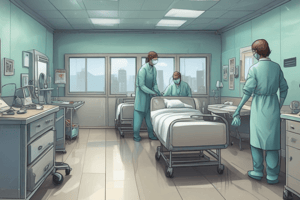Podcast
Questions and Answers
What is infection control?
What is infection control?
The methods used to eliminate or reduce the transmission of infectious organisms from one individual to another.
Define cleaning.
Define cleaning.
A mechanical process using soap and water or detergent and water to remove all visible dirt, debris, and many disease-causing germs.
What is sanitation?
What is sanitation?
A chemical process for reducing the number of disease-causing germs on cleaned surfaces to a safe level.
What is disinfection?
What is disinfection?
What is sterilization?
What is sterilization?
____ agencies set guidelines for the manufacture, sale, and use of equipment and chemical ingredients.
____ agencies set guidelines for the manufacture, sale, and use of equipment and chemical ingredients.
____ agencies regulate licensing, enforcement, and your conduct when you are on the job.
____ agencies regulate licensing, enforcement, and your conduct when you are on the job.
The ____ was created as part of the U.S. Department of Labor to regulate and enforce safety and health standards.
The ____ was created as part of the U.S. Department of Labor to regulate and enforce safety and health standards.
What do OSHA standards address?
What do OSHA standards address?
How does OSHA regulate and enforce safety and health in the workplace?
How does OSHA regulate and enforce safety and health in the workplace?
What is a Safety Data Sheet (SDS)?
What is a Safety Data Sheet (SDS)?
The ____ registers all types of disinfectants sold and used in the United States.
The ____ registers all types of disinfectants sold and used in the United States.
What are disinfectants?
What are disinfectants?
If you do not follow the label instructions for mixing, you are not complying with ____.
If you do not follow the label instructions for mixing, you are not complying with ____.
____ exist to protect beauty professionals' and their customers' health and safety during services.
____ exist to protect beauty professionals' and their customers' health and safety during services.
State regulatory agencies include?
State regulatory agencies include?
Laws are also called ____.
Laws are also called ____.
What is a disease?
What is a disease?
What is an infection?
What is an infection?
A ____ business helps build client confidence by providing a safe and sanitary environment.
A ____ business helps build client confidence by providing a safe and sanitary environment.
The most common types of transmission in salons, spas, or barbershops are?
The most common types of transmission in salons, spas, or barbershops are?
What is direct transmission?
What is direct transmission?
What is indirect transmission?
What is indirect transmission?
What are possible vectors of indirect transmission?
What are possible vectors of indirect transmission?
How are respiratory droplet and airborne transmission similar?
How are respiratory droplet and airborne transmission similar?
____ are large particles that do not stay suspended in the air for long.
____ are large particles that do not stay suspended in the air for long.
Flashcards are hidden until you start studying
Study Notes
Infection Control
- Infection control includes methods to eliminate or reduce transmission of infectious organisms between individuals.
Cleaning
- Cleaning is a mechanical process using soap or detergent to remove visible dirt and many germs, also eliminating debris that interferes with disinfection.
Sanitation
- Sanitation is a chemical process that reduces disease-causing germs on cleaned surfaces to a safe level.
Disinfection
- Disinfection involves a chemical process for nonporous items, using specific products to destroy harmful organisms (excluding bacterial spores) on surfaces.
Sterilization
- Sterilization destroys all microbial life, including spores, typically performed using an autoclave.
Regulatory Agencies
- Federal agencies set guidelines for the manufacture, sale, and use of equipment and chemical ingredients.
- State agencies regulate licensing, enforcement, and professional conduct in the workplace.
OSHA
- The Occupational Safety and Health Administration (OSHA) is part of the U.S. Department of Labor, enforcing safety and health standards for employee protection.
OSHA Standards
- OSHA addresses handling, mixing, storing, disposing of products, workplace safety, and the right to know about hazardous ingredients.
Safety Data Sheet (SDS)
- SDS is a 16-category, standard-format document that communicates product hazards and replaces MSDS or PSDS.
Environmental Protection Agency (EPA)
- The EPA registers all disinfectants sold and used in the U.S.
Disinfectants
- Disinfectants are EPA-approved products that eliminate most bacteria (excluding spores), fungi, and viruses on surfaces.
Compliance with Federal Law
- Failure to follow label instructions for disinfectants regarding mixing, contact time, and surface application constitutes non-compliance with federal law.
Health and Safety Regulations
- State regulatory agencies are in place to protect health and safety during personal services, including licensing agencies and health departments.
Legal Terminology
- Laws are also referred to as statutes.
Disease Definition
- A disease is an abnormal condition affecting the body's systems or organs, impeding normal function.
Infection Definition
- An infection is the invasion of body tissues by disease-causing pathogens.
Business Environment
- A clean and orderly business fosters client confidence, ensuring a safe, sanitary environment for services.
Transmission Types
- Common transmission methods in salons, spas, and barbershops include direct, indirect, airborne, and respiratory droplet transmission.
Direct Transmission
- Direct transmission occurs through physical contact such as touching, kissing, or talking.
Indirect Transmission
- Indirect transmission involves blood or body fluids spread via contaminated objects (like razors or surfaces).
Vectors of Indirect Transmission
- Common vectors include doorknobs, phones, food-preparation surfaces, and workplace implements.
Respiratory Transmission
- Respiratory droplet and airborne transmission happen when pathogens from the respiratory tract are expelled during coughing, sneezing, or talking.
Airborne Particles
- Large particles in airborne transmission do not remain suspended in the air for extensive periods.
Studying That Suits You
Use AI to generate personalized quizzes and flashcards to suit your learning preferences.




